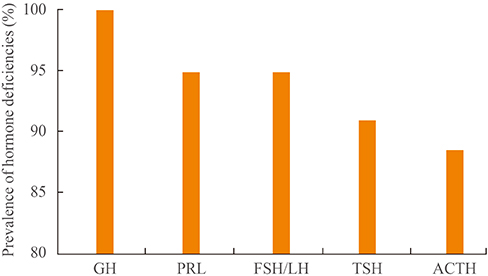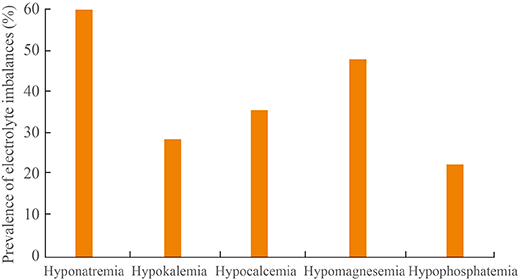Endocrinol Metab.
2015 Dec;30(4):502-508. 10.3803/EnM.2015.30.4.502.
Electrolyte Imbalance in Patients with Sheehan's Syndrome
- Affiliations
-
- 1Department of Internal Medicine, Chonnam National University Medical School, Gwangju, Korea. imagine-jjo@hanmail.net
- KMID: 2169659
- DOI: http://doi.org/10.3803/EnM.2015.30.4.502
Abstract
- BACKGROUND
We investigated the prevalence of electrolyte imbalance and the relationship between serum electrolyte and anterior pituitary hormone levels in patients with Sheehan's syndrome.
METHODS
In a retrospective study, we investigated 78 patients with Sheehan's syndrome. We also included 95 normal control subjects who underwent a combined anterior pituitary hormone stimulation test and showed normal hormonal responses.
RESULTS
In patients with Sheehan's syndrome, the serum levels of sodium, potassium, ionized calcium, magnesium, and inorganic phosphate were significantly lower than those in control subjects. The prevalence of hyponatremia, hypokalemia, hypocalcemia, hypomagnesemia, and hypophosphatemia in patients with Sheehan's syndrome was 59.0% (n=46), 26.9% (n=21), 35.9% (n=28), 47.4% (n=37), and 23.1% (n=18), respectively. Levels of sodium and ionized calcium in serum were positively correlated with levels of all anterior pituitary hormones (all P<0.05). Levels of potassium in serum were positively correlated with adrenocorticotrophic hormone (ACTH) and growth hormone (GH) levels (all P<0.05). Levels of inorganic phosphate in serum were positively correlated with levels of thyroid-stimulating hormone, prolactin, and GH (all P<0.05), and levels of magnesium in serum were positively correlated with delta ACTH (P<0.01).
CONCLUSION
Electrolyte imbalance was common in patients with Sheehan's syndrome. Furthermore, the degree of anterior pituitary hormone deficiency relates to the degree of electrolyte disturbance in patients with this disease.
Keyword
MeSH Terms
-
Adrenocorticotropic Hormone
Calcium
Electrolytes
Growth Hormone
Humans
Hypocalcemia
Hypokalemia
Hyponatremia
Hypophosphatemia
Hypopituitarism*
Magnesium
Pituitary Hormones, Anterior
Potassium
Prevalence
Prolactin
Retrospective Studies
Sodium
Thyrotropin
Adrenocorticotropic Hormone
Calcium
Electrolytes
Growth Hormone
Magnesium
Pituitary Hormones, Anterior
Potassium
Prolactin
Sodium
Thyrotropin
Figure
Reference
-
1. Sheehan HL. Post-partum necrosis of the anterior pituitary. Ir J Med Sci. 1948; 241–255.2. Sheehan HL. The frequency of post-partum hypopituitarism. J Obstet Gynaecol Br Commonw. 1965; 72:103–111.3. Tomlinson JW, Holden N, Hills RK, Wheatley K, Clayton RN, Bates AS, et al. Association between premature mortality and hypopituitarism. West Midlands Prospective Hypopituitary Study Group. Lancet. 2001; 357:425–431.4. Regal M, Paramo C, Sierra SM, Garcia-Mayor RV. Prevalence and incidence of hypopituitarism in an adult Caucasian population in northwestern Spain. Clin Endocrinol (Oxf). 2001; 55:735–740.5. Kovacs K. Sheehan syndrome. Lancet. 2003; 361:520–522.6. Kelestimur F. Sheehan's syndrome. Pituitary. 2003; 6:181–188.7. Boulanger E, Pagniez D, Roueff S, Binaut R, Valat AS, Provost N, et al. Sheehan syndrome presenting as early post-partum hyponatraemia. Nephrol Dial Transplant. 1999; 14:2714–2715.8. Dokmetas HS, Kilicli F, Korkmaz S, Yonem O. Characteristic features of 20 patients with Sheehan's syndrome. Gynecol Endocrinol. 2006; 22:279–283.9. Melmed S, Jameson JL. Chapter 339, Disorders of the anterior pituitary and hypothalamus. Harrison's principles of internal medicine. 18th ed. New York: McGraw-Hill;2012. p. 2876–2902.10. De Bellis A, Kelestimur F, Sinisi AA, Ruocco G, Tirelli G, Battaglia M, et al. Anti-hypothalamus and anti-pituitary antibodies may contribute to perpetuate the hypopituitarism in patients with Sheehan's syndrome. Eur J Endocrinol. 2008; 158:147–152.11. Lee BK, Shin DB, Kim SW, Yang IM, Kim JW, Kim YS, et al. The combined pituitary stimulation test in Sheehan's syndrome. Korean J Med. 1987; 33:36–43.12. Kilicli F, Dokmetas HS, Acibucu F. Sheehan's syndrome. Gynecol Endocrinol. 2013; 29:292–295.13. Smith DM, McKenna K, Thompson CJ. Hyponatraemia. Clin Endocrinol (Oxf). 2000; 52:667–678.14. Sert M, Tetiker T, Kirim S, Kocak M. Clinical report of 28 patients with Sheehan's syndrome. Endocr J. 2003; 50:297–301.15. Hansen TK, Moller J, Thomsen K, Frandsen E, Dall R, Jorgensen JO, et al. Effects of growth hormone on renal tubular handling of sodium in healthy humans. Am J Physiol Endocrinol Metab. 2001; 281:E1326–E1332.16. Dimke H, Flyvbjerg A, Frische S. Acute and chronic effects of growth hormone on renal regulation of electrolyte and water homeostasis. Growth Horm IGF Res. 2007; 17:353–368.17. Greenlee MM, Mitzelfelt JD, Duke BJ, Al-Khalili O, Bao HF, Eaton DC. Prolactin stimulates sodium and chloride ion channels in A6 renal epithelial cells. Am J Physiol Renal Physiol. 2015; 308:F697–F705.18. Stachenfeld NS, Keefe DL. Estrogen effects on osmotic regulation of AVP and fluid balance. Am J Physiol Endocrinol Metab. 2002; 283:E711–E721.19. Klibanski A, Greenspan SL. Increase in bone mass after treatment of hyperprolactinemic amenorrhea. N Engl J Med. 1986; 315:542–546.20. Pantazi H, Papapetrou PD. Changes in parameters of bone and mineral metabolism during therapy for hyperthyroidism. J Clin Endocrinol Metab. 2000; 85:1099–1106.21. Beshyah SA, Thomas E, Kyd P, Sharp P, Fairney A, Johnston DG. The effect of growth hormone replacement therapy in hypopituitary adults on calcium and bone metabolism. Clin Endocrinol (Oxf). 1994; 40:383–391.22. Nunoda S, Ueda K, Kameda S, Nakabayashi H. Sheehan's syndrome with hypomagnesemia and polymorphous ventricular tachycardia. Jpn Heart J. 1989; 30:251–256.
- Full Text Links
- Actions
-
Cited
- CITED
-
- Close
- Share
- Similar articles
-
- A case of Sheehan's syndrome presented by recurrent ventricular tachycardia
- A Case of Sheehan's Syndrome with Pancytopenia
- A case of Sheehan's syndrome with central diabetes insipidus showing hemorrhagic pituitary apoplexy
- Case of Sheehan's Syndrome Misdiagnosed as Pituitary Apoplexy due to Pituitary Adenoma
- Antimicrobial-induced Electrolyte and Acid-Base Disturbances



